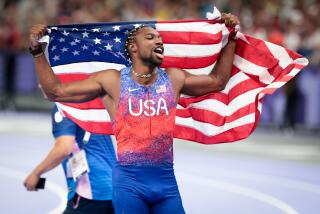This is track as it should be
- Share via
EUGENE, ORE. — Speaking with running legend Alberto Salazar late last week I noted that I was heading off to the Prefontaine Classic, the celebration of track and field held each year in Eugene, Ore. This, I told him, would be my first “Pre.”
“You’re going to love it,” Salazar replied. “It’s condensed. Just a few hours of nonstop action. Incredible fans . . . If it’s going to catch on in this country, this is the way track should be.”
It didn’t take long on Sunday to see that Salazar was right, on all counts.
The 35th edition of this meet was something like the man it posthumously honors: the dashing, daring, iconoclastic Steve Prefontaine, a middle-distance star at Oregon in the early 1970s.
This was a memorable day. A day that featured a top-flight international cast -- more than 30 Beijing Olympic medalists -- and was, as it is every year, short and sweet. Unlike most track meets, some of which slog on from dusk to dawn and even extend for half a week, there weren’t any preliminary heats or frivolous competition. Everything counted. This was roughly 120 minutes of final races, final jumps and final throws.
Maybe most impressive was the vibe: for two hours at Hayward Field, as iconic a track stadium as exists in America, a sold-out crowd of nearly 13,000 rocked-and-rolled with applause and rhythmic clapping. Close your eyes and you could imagine you were at a college football game. Better yet, maybe a track meet in Europe, where the sport receives the full measure of respect it deserves.
One of the few American places where track matters like this, maybe the only place it does year-in and year-out, is Eugene. The forest-shrouded college town brought the world not only Prefontaine but Salazar, Nike and Bill Bowerman, the legendary track coach who took over at Oregon in 1948, winning four NCAA championships while coaching scores of All-Americans and Olympians. Eugene has steeped in track for so long now that the sport is simply a part of the overall DNA. (Full disclosure: my cousin, Libby Tower, helps market the sport there.)
Eugene is the kind of place, said Jim Imamura, an Oregon physics professor on hand for Sunday’s meet, where you go to dinner, stop by a cafe or hang around the office cubicle and people are just as likely to start a conversation about track as they are about the Rose Bowl. “Football has gotten pretty big here, but track is still the core, the center of this place,” he said, noting that this year he’s also attended the recent Pac-10 championships and the NCAA regionals.
As I watched Sunday’s meet I wondered why the love of track -- a supreme and sublime test of skill and athleticism -- doesn’t translate throughout America. It’s too much to expect track will ever be a truly big deal on our shores, but it’s easy to forget there was a time when meets in places such as L.A. had real sizzle. They mattered. People who didn’t care about track paid attention. These days -- well, sadly, not so much.
Could be that the major sports and their gazillion-dollar marketing machines have simply stomped all life from less glitzy cousins like track. Could be, too, that the unending slog of doping scandals have done irreparable damage.
There are no easy answers. Bottom line, an event like the Prefontaine Classic is something to cherish on its own.
I wrote that last sentence from the press box here, my skin crawling with goose bumps as I watched a tight, taut, loudly cheered men’s 3,000-meter race: Kenyan-born American Bernard Lagat, a two-time Olympic medalist, held off Saif Shaheen of Qatar in a chess-like duel.
“You just want to do something for these fans,” said Lagat when it was over. Running at Hayward Field, he said, makes him feel appreciated, respected and understood. “It’s really special here,” he said. “I felt that on the track today.”
Lagat’s was hardly the only great performance. A small slice here. In the men’s mile, an eye-popping 13 men ran under four minutes, an event won by Kenyan Asbel Kiprop in 3:48:50.
Jenny Barringer, a senior at Colorado, took second in the 1,500 meters, but her time of 3:59.90 made her just the third American woman to race that distance in less than four minutes.
Then there was American Dwight Phillips, whose long jump of 28 feet 8 1/4 inches was the best since Mike Powell’s world record of 29-4 1/2 in 1991. When Phillips landed, even before the distance was listed on a scoreboard, the crowd rose in unison, fervently celebrating. They didn’t need a scoreboard to know what they’d just witnessed was great. In Eugene the fans are aficionados, the track equivalent of wine lovers who know every brand and all the vintners, every grape and every last one of the good years.
Those fans, and the often overlooked athletes they supported, made the 2009 Prefontaine Classic something to behold.
--
More to Read
Go beyond the scoreboard
Get the latest on L.A.'s teams in the daily Sports Report newsletter.
You may occasionally receive promotional content from the Los Angeles Times.







